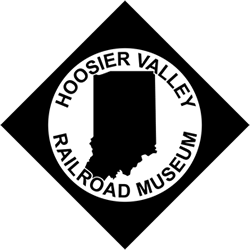The depot and gift shop are currently closed for the winter season.
This article was extracted from the Hoosier Valley Railroad Museum Newsletter of April 1995. Since Walt's visit, much has changed at the museum, including the demise of the JK Line, the expansion of the museum, and the saving of the former C&O mainline. Much of the rail mentioned in the article can still be viewed, but please remember that the museum is an active railroad and you should stay clear of the track and be prepared to expect a train on any track at any time.
Rail at the Museum
By Walt Pluchinsky of Crown Point, Indiana
As warm weather approaches, most railroad enthusiasts are eager to resume the various activities that were reluctantly curtailed when the cold weather hit. I'm no exception, and I plan to continue my search for old rails, their origins and sizes, for any historical significance. Last fall, I've done some "looking" at the HVRM, and I'd like to share some of my findings.
If one closely looks at some of the rails that are piled around the museum, or in track, an occasional rail with branding (identification marking) painted white my be seen. It's just my attempt to highlight the brand by using a light touch of a paint pad for photographing, as I pursued my hobby.
It should be explained that modern rails are made to specifications governed by the American Railroad Engineering Association (AREA), which includes identification. Most of us are familiar with a rail's raised lettering, called the "brand", which gives the manufacturer, the month and year rolled, weight or section number, AREA, and CC (standing for control cooled). The section number also included the rail weight in pounds per yard. The opposite side of the web contains depressed stamping of the heat (melt) number, rail letter, and ingot number. To my knowledge, there are currently only two active rail mills in this country: Bethlehem Steel, Steelton, PA., (now called Pennsylvania Technologies), and Colorado Fuel and Iron, Pueblo, Colo. Older rails may not contain all of the identification required by specs.
Research has indicated a wide variety of rails at the HVRM, most of which are quite old, and represent product from at least 11 rail mills. Many rails are local: US Steel's Gary Works (with ILLINOIS branding), and those marked INLAND. Many, however, have found their way from the east, as we see numerous Bethlehem Steel products, with brands of CAMBRIA (Johnstown, Pa.), MARYLAND (Sparrows Point, Md.), LACKAWANNA (Buffalo, NY), and STEELTON. US Steel's Edgar Thompson Works, Braddock, Pa. (CARNEGIE brand) is also prominent. I didn't know Republic Steel made rails until saw one branded REPUBLIC, 85 lb. 1905" on a siding. Lastly, did you know your museum has rails from three countries? One, of course is USA, but we have rails from Germany (branded KLOCKNER), and from Canada-Nova Scotia (branded SYDNEY). Time has taken its toll on many of the rails, but surprisingly many old rails are still quite legible, including heat number stamping.
Again, there are at least 14 different rail sections at HVRM, either in track on in various piles. The lightest found as 67 pound (branded MARYLAND 67 03) and the heaviest was 132 pound (branded CARNEGIE 132-25 1949). Most sizes found are no longer made, and include 90-31, 105-24, 105-23, 131-28, 100-31, and 127-22. The oldest rail seen was made in 1894 (CARNEGIE), and the newest was rolled in 1986 (SYDNEY). As a matter of interest, the track that is used by the JK Line contains larger rails, typical 132-25 (INLAND 1949, CARNEGIE 1949, TENNESSEE 1975), and 131-28 (ILLINOIS 1945).
So, perhaps the next sojourn to the museum will prompt the enthusiast to look at the rails and search out a little bit of history. You just might find something interesting, or just learn a little bit more about railroading in general. Who knows, you just might stumble onto a rail whose identity just happened to be the place where one of your relatives worked long ago.
Hoosier Valley Railroad Museum
P.O. Box 75
North Judson, Indiana 46366
Call or Email
574-896-3950 Depot Phone
[email protected]

